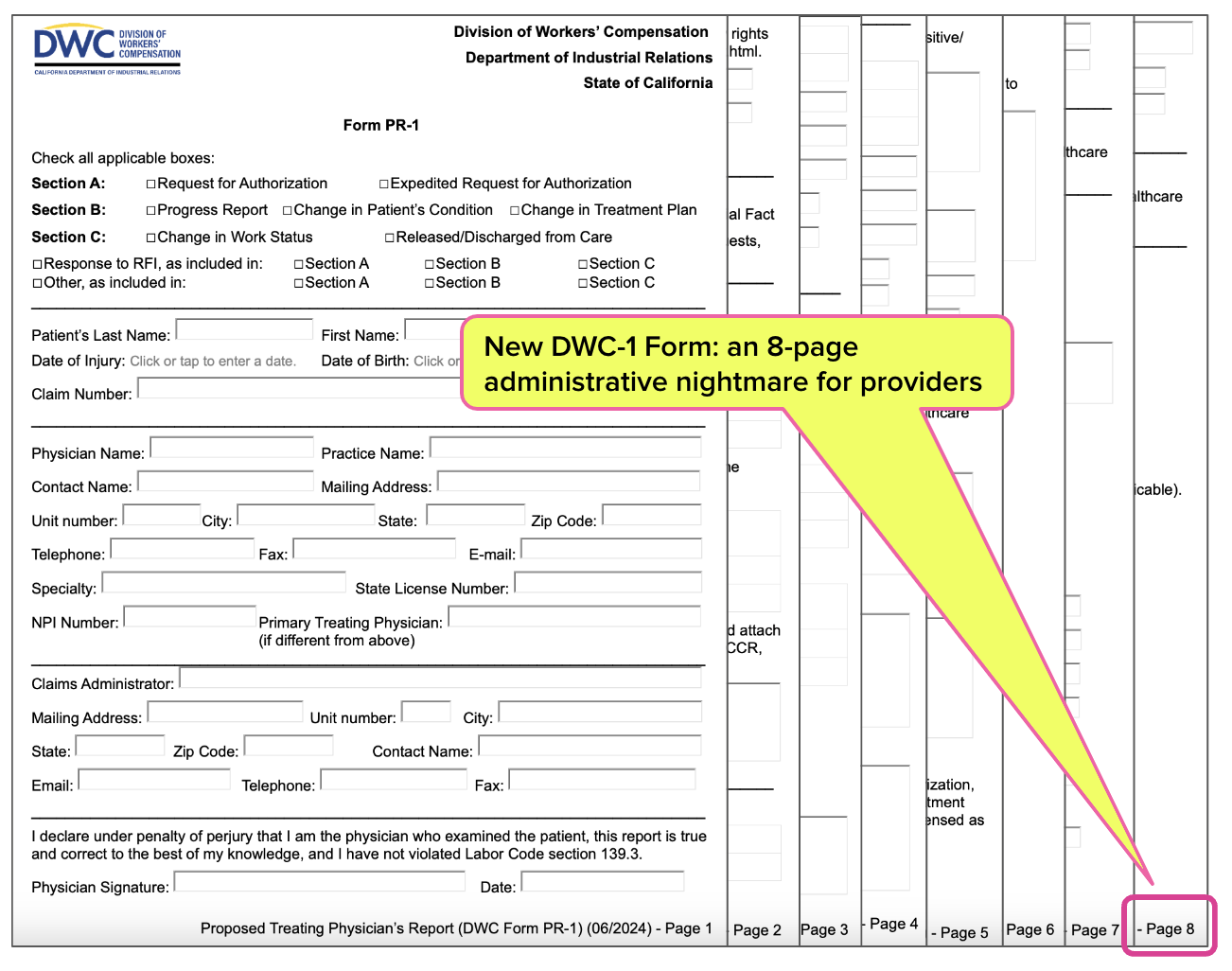CA DWC to Impose Costly New Reporting Burdens on Providers
.gif)
California’s Division of Workers’ Compensation (DWC) is proposing major changes to the forms providers use for injured workers’ Progress Reports, the Doctors’ First Report of Occupational Injury, Permanent and Stationary Reports, and Requests for Authorization (RFAs).
If enacted, these changes will impose significant new administrative burdens and costs on providers who treat injured workers while (as usual) leaving claims administrators free to do as they please.
As the DWC openly acknowledges, the costs of implementing the new forms and overhauling current processes will fall entirely on providers.
The agency is holding a public hearing to discuss the changes tomorrow, July 25, 2024. A daisyBill representative is attending. Members of the public may attend or submit written comments (details below).
If experience is any indication, the DWC meeting will be filled with claims administrators, their private equity owners, vendors, and lobbyists—the entities that enrich themselves through the plight of injured workers. Meanwhile, providers will be in their offices caring for those injured workers.
DWC Proposes New PR-1 Form for Providers
According to a DWC Newsline, the proposed changes are to Utilization Review (UR) regulations. However, the extent and impact of the proposed changes extend well beyond UR.
The DWC proposes releasing a new form, the PR-1, which combines progress reports with treatment authorization requests. The 8-page PR-1 (shown below) would be a “Frankenform” of the Form RFA, which providers currently use to request treatment authorization, and the Treating Physician’s Progress Report (Form PR-2).
In its Initial Statement of Reasons (ISOR), the DWC acknowledges that transitioning to this new authorization and reporting form will require providers to modify existing practice records systems and reporting protocols—an administratively complex and costly proposition for providers.
Most frustratingly, the text of the proposed regulations indicates that claims administrators will dictate how and where providers must send the PR-1 for authorization and billing purposes. Given that the PR-1 will pull double duty as the official request for authorization form and physician’s progress report, the DWC allows claims administrators to designate two destinations for this single form.
The DWC proposals allow each claims administrator to dictate the fax or email address a provider must use to submit the PR-1 for authorization purposes. The proposals do not restrict claims administrators from having multiple fax or email addresses for receiving the PR-1 for treatment authorization purposes.
For billing purposes, the proposals allow each claims administrator to dictate the fax, email, or mailing address a provider must use to submit the PR-1 form with the bill. The DWC does not restrict claims administrators from maintaining multiple fax numbers, email addresses, or mailing addresses to submit the bill with the PR-1.
Strangely, the proposed changes do not require the claims administrator to furnish providers with the information required to send an electronic bill, such as the clearinghouse or Payer ID.
The possible combinations of delivery instructions for the PR-1 across the hundreds of California claims administrators mean that providers will need to track thousands of different delivery variations to comply. These anarchic proposals are folly—and evidence of the DWC’s apparent disdain for providers.
For providers, administrative chaos is inevitable.
DWC Conceals New Doctor’s First Report Form 5021
The proposed regulations' text is filled with errors and omissions, illustrating the DWC’s ineptitude (but not, we hope, outright obfuscation).
For example, the proposals would amend California Code of Regulations Section 9785 to require the initial physician to submit a new version of the Doctor’s First Report of Occupational Injury “set forth in section 14006.1.” Section 14006 links to the current Form 5021, but no section 14006.1 exists in the regulations.
In other words, the DWC is proposing a new 5021 form, but is not providing a way for the public—or the providers who will bear the cost of its implementation—to view or comment on it.
Further, the DWC would amend the regulations to require only the initial physician to submit the First Report, in contradiction of California law. According to Labor Code Section 6409, every physician (as defined in Section 3209.3) who attends to an injured employee shall file a complete report of that occupational injury or illness.
While this amendment may or may not be prudent, the apparent impunity with which the DWC disregards state law is astounding (but hardly surprising). Of course, the DWC is only exercising the exact same impunity with which it allows claims administrators to disregard California laws and regulations daily.
DWC Conceals New Permanent and Stationary Report Forms
The DWC’s proposed regulations also indicate that there will be changes to the forms for Permanent and Stationary Reports, the PR-3 and the PR-4. However, the DWC does not share the details of these changes. According to the proposed changes, these forms will be located in two new regulations sections: 9785.3.1 and 9785.4.1.
As with the new Doctor’s First Report, neither of these sections exist in the regulations.
Again, the DWC is proposing two new forms, but keeping these forms shrouded in mystery.
DWC to Providers: Buckle Up and Eat the Costs
Transitioning to the PR-1, the new Doctor’s First Report, and new Permanent and Stationary Reports will require providers to undertake a colossal administrative lift, costing practices money, time, and resources. The DWC is well aware of this. As it states in its ISOR (emphasis ours):
“Businesses [as in medical practices] that decide to tweak or adapt their existing systems (such as those which employ an electronic health records program) to better align their programs with the new/amended forms may, at first, experience an increase in cost.”
And exactly how will providers bear that cost?
Evidently, the DWC expects providers to expend the resources necessary to comply with proposals that grant claims administrators even more power to administratively hamper providers—all while allowing those claims administrators to use Preferred Provider Organizations (PPOs) and Medical Provider Networks (MPNs) to circumvent state fee schedules and pay less than Medicare rates for injured workers’ treatment.
Perhaps worst of all, the DWC could have proposed reforms that actually improve injured workers’ access to care, by making authorization and UR more efficient and equitable.
The DWC could require a standardized response to RFAs so providers don’t have to deal with bloated, unintelligible UR decisions. They could follow the law (in place since 2016) that requires the DWC to collect UR data to monitor claims administrators for abuse and non-compliance. They could uphold the sanctity of authorization instead of allowing MPN-based denials.
Instead, the DWC chose to propose a massive administrative burden for providers already struggling to treat injured workers in a financially sustainable way.
The DWC is not making this meeting publicly available online. Instead, the agency expects providers to schlep to Oakland (rather than spend their time treating injured workers). The public is “invited” to attend the in-person hearing on Thursday, July 25, 2024, at 11 AM at the following address:
Elihu Harris State Office Building – Auditorium
1515 Clay Street
Oakland, CA 94612
Members of the public may also submit written comments via mail, fax, or email until the end of the day on Thursday, as follows:
Maureen Gray, Regulations Coordinator
Department of Industrial Relations
1515 Clay Street, 18th Floor
San Francisco, CA 94142
Fax: (510) 286-0687
Email: dwcrules@dir.ca.gov
All the details of the proposals are available on this DWC web page. Note that the DWC’s Notice of Proposed Rulemaking offers a different mailing address for submitting written comments than the address above, which the DWC included in its Newsline announcing the meeting. The address listed in the Notice is as follows:
Maureen Gray, Regulations Coordinator
Department of Industrial Relations
P.O. Box 420603
San Francisco, CA 94142
To keep providers informed, daisyNews will report on this meeting, as well as additional details of the proposed changes. But so far, all signs indicate the status quo: claims administrators (along with their private equity owners and sidekick vendors) profit while injured workers suffer.
daisyBill tracks responses to your bills, appeals, and RFAs — so your practice knows when payers break the rules. Click below to learn more, or request a demonstration.
LEARN MORE
DaisyBill provides content as an insightful service to its readers and clients. It does not offer legal advice and cannot guarantee the accuracy or suitability of its content for a particular purpose.





.png)


